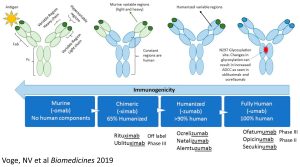1

INJECTABLES
The first disease-modifying drug, interferon β-1b, was FDA approved in 1993 (1). Interferons are naturally occurring cytokines that are reported to have a wide range of both inflammatory and anti-inflammatory properties. Interferon β1’s mechanism of action is quite complex and includes: increasing production of anti-inflammatory cytokines such as IL-10 and downregulating production of proinflammatory cytokines including IL-17 (2). Together, interferon β1 reduces relapse rate and slows accumulation of new lesions. There are now multiple interferon β1 options for patients. In 2014, a PEGylated version, peginterferon β-1a, was approved. The PEG moiety extends the half-life of interferon β1 which is injected every two weeks. The most common side-effects of interferon β1-based treatments are flu-like symptoms and injection site reactions.
Glatiramer acetate is a synthetic polypeptide made up of a combination of four amino acids (tyrosine, alanine, glutamate, and lysine) which mimic myelin basic protein. By injecting this into MS patients, it competes with myelin peptides for binding to major histocompatibility molecules (MHC) on antigen presenting cells. Glatiramer acetate is also an antagonist at the T cell receptor and induces proliferation of regulatory T cells which are anti-inflammatory lymphocytes (3). As with interferon β1 treatments, injection site reactions are the most common side effects. However, lipoatrophy has also been reported.
INFUSIONS
Bioengineering techniques have resulted in progressively more humanized antibodies. The figure below shows the different fractions of the monoclonal antibodies and whether they represent mouse (green) or human (blue) sequences. As the sequences become more humanized their immunogenicity decreases. Glycosylation occurs at amino acid N297 and affects antigen-dependent cellular cytotoxicity. Each monoclonal antibody has a different mechanism of action.

Ocrelizumab and ofatumumab targets CD20 expressing B cells. Natalizumab targets transmigration of lymphocytes through the blood brain barrier. Alemtuzumab targets CD52 expressing lymphocytes for depletion. Other drugs include: rituximab and ublituximab which also target CD20 expressing B cells and opicinumab, which helps oligodendrocyte precursor cells differentiate into myelin producing oligodendrocytes. Given that these monoclonal antibodies target the immune system, all of these drugs come with a warning for an increased risk of infection.
NON-INJECTABLES
There are now disease modifying drugs available in oral formulations.
Fingolimod, siponimod and Zeposia®, and are in a new class of medications. They too work on lymphocytes but target the sphingosine 1-phosphate receptor, to prevent lymphocytes from exiting lymph nodes. By retaining lymphocytes in the lymph nodes, these cells are unable to cross the blood-brain barrier reducing inflammatory damage to nerve cells. All three of these drugs are known to cause bradyarrhythmia and heart block and are contraindicated in patients with heart problems or stroke. Stopping these medications can lead to an exacerbation of MS symptoms that can lead to permanent disability.
Dimethyl fumarate is a Nrf2 activator. Nrf2 is a transcription factor that regulates the expression of genes involved in the oxidative stress response (4). By increasing the activity of Nrf2, dimethyl fumarate causes an increase in anti-oxidant and anti-inflammatory activity and overall reduction of inflammatory cytokines. The most common side effect of dimethyl fumarate is flushing. There is a high incidence of lymphopenia which is due to the effect dimethyl fumurate has on immune cell survival.
Teriflunomide is a reversible inhibitor of dihydro-orotate dehydrogenase. This enzyme is a mitochondrial protein required for the de novo pyrimidine synthesis pathway (5). Teriflunomide was shown to reduce proliferation of activated T and B lymphocytes without causing cell death.
